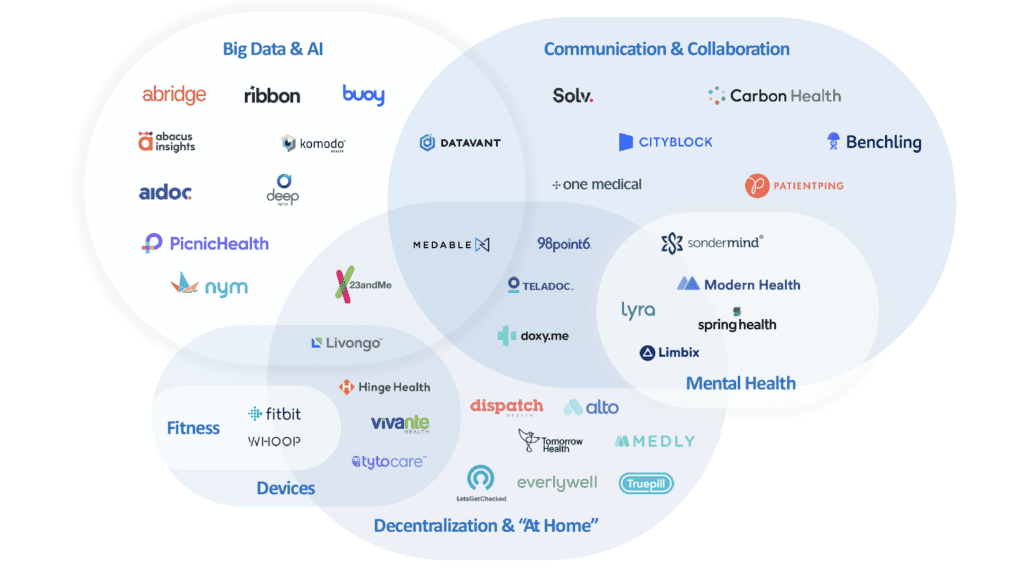“It is not the strongest of the species that survives, nor the most intelligent, but the one most responsive to change.” – Charles Darwin
In recent years, the gap between technological innovation and adoption in healthcare has increasingly become more pronounced. On one hand, the healthcare industry has been able to produce CRISPR gene editing (modification of the genomes of living organisms), cloning, bionic eyes and a number of other incredible, science fiction-like innovations. But on the other, before COVID-19, the industry primarily operated on and still very much operates on pen and paper. It’s perplexing that decades after electronic health care records have become the norm, HIPAA compliant digital intake forms are still not yet commonplace.
This dichotomy doesn’t stem from an absence of new and exciting technologies in the space, often created and pushed forward by operators. Many health tech start-ups like Doximity, Medable (a recent addition to the Sapphire portfolio) and ZocDoc were started by physicians and clinicians who spotted areas in their work that could be solved by technology. The challenge lay in the hurdles associated with scaling these kinds of technologies systemwide. Within healthcare especially, and like many highly regulated industries, there are constraints around setting standards from a regulatory perspective (which are there for good reason!) and more nefariously, the general inertia that often plagues any big system.
While the technology that enables telehealth and digital intake form signing have been available for decades and offer clear benefits when compared to traditional methods, adoption has been slow to take-off. For better or worse, the onset of COVID-19 quickly exposed the many limitations and weaknesses within the current healthcare system such as a reliance on delivering care at physical sites, which can often introduce inconvenience, inflexibility and barriers to the best access and the best care for patients. As a result, the pandemic has been a tremendous catalyst for accelerating technological adoption in the healthcare industry, altering the regulatory landscape and cutting through inertia, in order to build the foundation for a new normal.
A recent report by McKinsey revealed that during COVID-19, providers saw 50 to 175 times the number of patients via telehealth than they did before. This temporary spike in utilization appears to have changed consumer behavior and preferences that may long outlast the pandemic. According to the same study, only 11% of consumers used telehealth services in 2019 whereas now, 76% are interested in using telehealth going forward. Pre-pandemic, low utilization was partially due to structural factors like low reimbursement rates from carriers but arguably, the greater reason was simply patient familiarity with in-person visits. In a very short period of time, the conditions that the pandemic placed on the healthcare system has very rapidly changed how the industry operates, as well as consumer behaviors, opening the door for technological adoption now and in the future.
Within the healthcare industry, we’re seeing increased technological adoption from COVID-19 across three key dimensions: Big data and artificial intelligence (AI), communication and collaboration, and decentralization and the movement towards at-home care. Let’s explore each of these trends in detail.

How Big Data and AI Help the Industry Leap Forward
There are endless examples of how AI can help improve different industries, job functions, work processes and more. But in healthcare, AI holds the opportunity to be truly transformational for the benefit of people. Whether it’s deep learning in the field of computer vision to read x-rays or harnessing the power of big data for contact tracing, scientists and researchers are developing tools that I believe will dramatically improve the availability and quality of care.
The importance of leveraging big data and AI technologies within healthcare was highlighted at the start of the COVID-19 outbreak when the term “contact tracing” entered popular vocabulary as governments and research institutions around the world scrambled to understand and contain the virus. Other AI use cases during the pandemic include data visualization tools that leverage GPS information to map COVID-19 cases and utilizing predictive analytics as part of the search for a vaccine. The value of big data and AI has been little doubted in healthcare, but the recent events have put both into the limelight in a major way from a deployment perspective.
While COVID-19 has emphasized how big data and AI can work to help in the instances of massive healthcare emergencies, use cases expand far beyond this and we highlight a couple below:
- Using healthcare data to glean insights to better deliver care. Data in the healthcare industry is often fragmented and siloed. Komodo Health recently introduced a Healthcare Map, which is built on patient-encounter data and data algorithms that gives customers like pharma companies visibility and the ability to glean insights to help accelerate innovation. Datavant is another company in the space that helps stitch siloed data together using tokenization technology so customers (including Komodo Health) can form comprehensive datasets to run their algorithms on.
- AI for diagnosis. We rely on healthcare professionals to interpret tests and symptoms based on their training and experience, but with advances in technology, technology is offering a helping hand. Aidoc, for example, uses computer vision and AI to help detect and pinpoint critical anomalies for radiologists by analyzing medical images and patient images. Another startup, Buoy Health, analyzes symptoms communicated by users, producing a list of possible diagnoses based on 22,000 clinical papers, and from there interacts with users via an AI chatbot.
Communication and Collaboration Tools Drive Efficiency and Improve Patient Experience
Communication and collaboration, both internally with patients and across the healthcare ecosystem, became a challenge overnight when shelter-in-place orders rolled out across the country early this year. The shift left healthcare organization leaders and regulators searching for viable solutions that were enabled by existing basic technologies that consumers already use and are familiar with, such as messaging, text and video. After months of engaging with patients virtually and digitally, the ROI from these methods was clear. Healthcare professionals are able to save a tremendous amount of time, collect tons of rich and accurate data, which they can run analytics on, deliver real-time capabilities to their patients and better execute multi-party coordination.
The federal government also benefited from the move towards digital healthcare. It took the lead in utilizing digital communication methods by setting up a digital portal and requiring certain healthcare facilities to report COVID-19 cases and deaths at least once a week to the CDC. The amount of data that was required to be reported on and the general time-sensitive nature of the work meant that traditional methods like fax and mail were no longer an option. While barriers to virtual and digital communications existed prior to the pandemic, including reimbursement and regulatory restrictions, they went away almost instantaneously. Furthermore, for telemedicine, remote-care reimbursement was expanded and HIPAA penalties were waived. Many state health agencies also reduced state licensure barriers, allowing providers to practice across multiple states. Below are a few innovative companies focused on digital communication and collaboration that have taken off during this time, and are expected to be popular in the future:
- Virtual Visits and Mobile-Based Care. Alternatives to in-person visits including televisits and mobile-based care spiked during the pandemic, which increased demand for companies like 98Point6 that offer on-demand primary care services via text, as well as for telehealth services from providers like Teladoc and Doxy.me.
- Mental Health. As a subset of virtual and mobile-based care, mental health services in particular saw expanded utilization. Companies like Lyra Health and Spring Health connect users to licensed therapists virtually and also offer other forms of care via digital content.
- Instant Digital Scheduling and Coordination. Increased inbound inquiries tested the limits of relying on the traditional method of handling appointments by phone, opening the door to text and chat as popular alternatives. Existing tech forward providers such as One Medical already offered online and mobile bookings and communication channels. And Solv helped customers conveniently book same-day in-person appointments and instant video visits as easily as it is to book a restaurant reservation on OpenTable.
Decentralization and “At Home” Care Delivers Better Results, Faster
Decentralization is the distribution of authority and control from a central agency to local administrative level. Simply stated, it’s moving healthcare into the community and home. The benefits of decentralization include greater access to healthcare, better care, increased transparency and accountability, and improved speed and cost. On the flip side, decentralization often increases complexity in coordination and negatively impacts things like data collection and analytics. But these new challenges represent opportunities for healthcare technology companies–new and existing–to tackle.
The shift towards decentralization is starkly illustrated by clinical trials. Clinical trials have long been the primary method for testing and validating new drugs and therapies. Historically, over 70 percent of potential clinical trial participants live more than two hours away from the nearest study center, which greatly limits access and engagement. COVID-19 massively disrupted clinical trials worldwide as thousands of trials were suspended and new patient enrollment stopped entirely during lockdowns. The result? Significant ramifications on drug development timelines and long-term effects on medical science. While decentralized trials existed pre-COVID-19 on a very limited scale, a massive shift to decentralization was almost immediately triggered. A component of the broader theme of decentralization is the move towards at-home care. Instead of having to go to a facility, using technology, people can collect and self-report data, mail in tests and have virtual consultations from the comfort of their homes. Here, we explore a few of the technologies and applications enabling localized delivery of care:
- Decentralized Clinical Trials. By removing the barrier of having to physically travel to a study site, clinical trial participation is now an option for many more people around the world, ultimately enabling better discovery of therapies and drugs. Medable offers an end-to-end global platform that enables decentralized clinical trials by connecting patients, sites and clinical trial teams.
- Care and Testing from Home. It’s possible now to get tested on a variety of different conditions and traits at home. Examples include 23&Me (a Sapphire investment), Everlywell and ModernFertility–to name a few. It’s also an option to have prescription drugs delivered to your door by using companies like Alto and Medly. And last but not least, people can track their health via wearables and devices like FitBit (another Sapphire investment) and Whoop.
The Market Opportunity for HealthTech Has Never Been Greater
The pandemic has accelerated the adoption of existing healthcare technologies, and has paved a way for new technologies to positively impact the healthcare ecosystem. The unprecedented market opportunity hasn’t escaped investors as there has been a rush of venture funding in the sector. According to Rock Health, U.S. digital health companies raised $5.4B in venture funding in the first half of 2020–on track to be the largest funding year ever.
During COVID-19, technologies like Zoom and Instacart have boomed as companies and consumers raced to respond to the unique conditions brought on by the pandemic. In the healthcare space, the natural innovation cycle that may have taken several years has been accelerated into one, creating a new operating baseline. The move towards more digital technologies and tools in healthcare has resulted in a recent McKinsey report to estimate that up to $250 billion of current U.S. healthcare spend could potentially be virtualized.
At Sapphire Ventures, we’ve backed innovative companies in the digital health space for years, including 23&Me, FitBit, Medable and Livongo. We believe 2020 has opened the door to a massive acceleration in technological adoption in healthcare, and believe that these recent behavioral shifts will allow new Companies of Consequence to emerge.




